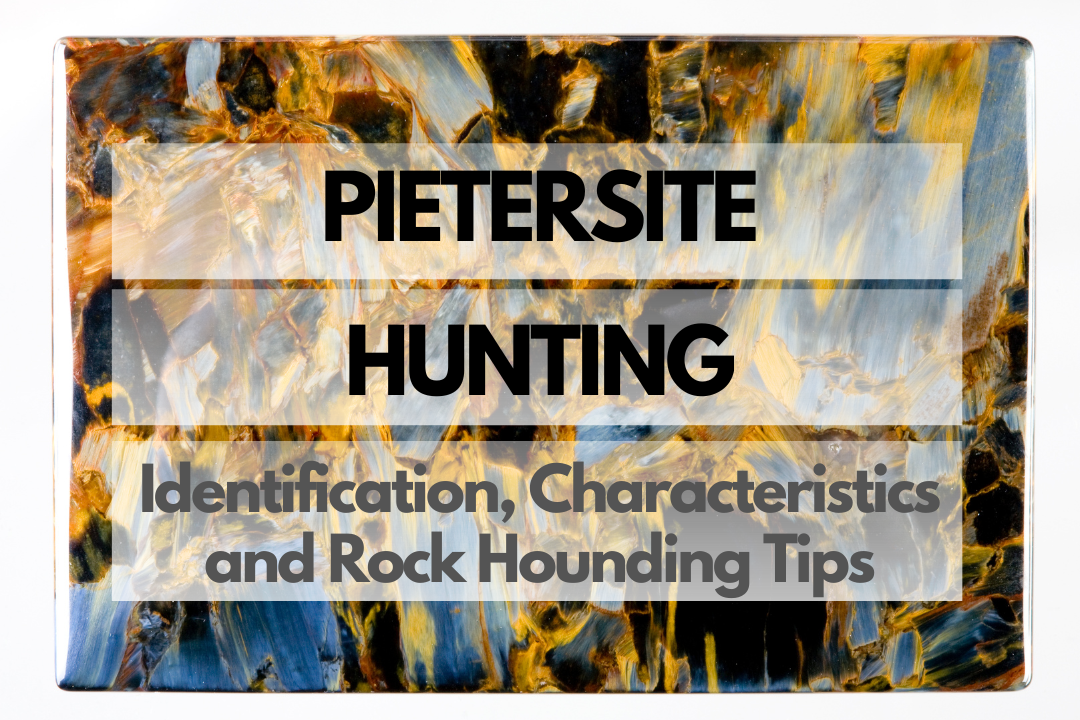Are you ready to delve into the world of pietersite hunting? This captivating gemstone, with its mesmerizing colors and patterns, has captured the hearts of rock hounds and collectors worldwide. In this article, we’ll guide you through the history, identification, characteristics, and rock hounding tips for this stunning gemstone. So, buckle up and prepare to embark on an exciting journey into the realm of pietersite!
History & Origin of Pietersite
Pietersite, a relatively recent discovery in the world of gemstones, was first found in 1962 by Sid Pieters in Namibia, Africa. The gemstone was subsequently named in his honor. Pietersite is a member of the quartz family, specifically a variety of the mineral called “hawk’s eye.” Its unique swirling patterns and vivid colors have earned it the nickname “Tempest Stone.” In addition to Namibia, pietersite can also be found in China, though the color variations differ between the two locations. Pietersite is often associated with spiritual transformation and is believed to possess strong metaphysical properties by various cultures.
Pietersite Identification & Physical Properties
| Property | Description |
|---|---|
| Mineral Class | Quartz (Hawk’s Eye) |
| Chemical Composition | SiO2 |
| Crystal System | Trigonal |
| Cleavage | None |
| Fracture | Uneven to conchoidal |
| Luster | Vitreous to silky |
Pietersite Colors
Pietersite boasts a stunning array of colors, ranging from deep blues and golden browns to vibrant reds and yellows. These colors swirl together to create unique patterns, which contribute to the stone’s desirability. The variation in color is a result of the presence of crocidolite fibers in the quartz, which undergo a process called pseudomorphosis and are eventually replaced by silica.
Pietersite Hardness
On the Mohs scale of mineral hardness, pietersite generally falls between 6.5 and 7. This makes it a relatively durable gemstone, suitable for use in jewelry and other decorative items. However, care should be taken to avoid scratching or chipping the stone, as it may be susceptible to damage from harder materials or impacts.
Pietersite Types
Namibian Pietersite
Namibian pietersite, found in Namibia, Africa, is characterized by its vibrant blue and gold colors. The swirling patterns of this type of pietersite often resemble stormy skies, which has led to its nickname “Tempest Stone.” Namibian pietersite is prized for its striking appearance and is highly sought after by collectors.
Chinese Pietersite
Chinese pietersite, originating from China, typically exhibits a different color palette compared to its Namibian counterpart. It often features more earthy tones, such as reds, browns, and yellows. While the patterns in Chinese pietersite are still mesmerizing, they tend to be more subdued than those in Namibian pietersite.
Pietersite Uses
- Jewelry: Due to its unique colors and patterns, pietersite is often used in various types of jewelry, including rings, pendants, and earrings.
- Carvings: Pietersite can be carved into intricate sculptures or decorative objects, showcasing its captivating appearance.
- Cabochons: Polished pietersite cabochons are popular for their unique patterns and are often used in jewelry or as display pieces.
- Metaphysical and spiritual practices: Pietersite is believed to possess strong metaphysical properties and is often used in meditation, energy work, and other spiritual practices.
How Much Is Pietersite Worth?
The value of pietersitecan vary depending on factors such as color, pattern, size, and quality. Generally, pietersite can range in price from around $5 per carat for lower-quality stones to over $50 per carat for high-quality specimens with exceptional color and pattern. Namibian pietersite tends to be more valuable due to its vibrant colors and striking patterns. Ultimately, the worth of pietersite is subjective and depends on the preferences and tastes of the buyer or collector.
Pietersite Rock Hounding Tips
Ready to embark on your pietersite hunting adventure? This section will provide you with valuable tips and tricks to ensure a successful and enjoyable experience. From essential tools to safety precautions and the best locations for finding pietersite, we’ve got you covered!
Essential Tools and Equipment
Having the right tools and equipment can make all the difference when it comes to rock hounding. Here are some essentials for a successful pietersite hunt:
- Rock hammer: A rock hammer is essential for breaking open rocks and extracting specimens.
- Chisel: A chisel can help you separate layers of rock and access hard-to-reach pietersite specimens.
- Hand lens: A hand lens or magnifying glass can help you identify small pietersite crystals and other interesting features.
- Sturdy gloves: Protect your hands from sharp rocks and edges with a pair of sturdy gloves.
- Backpack: A backpack will allow you to carry your tools, specimens, and other essentials with ease.
- Field guide: A field guide to rocks and minerals can help you identify pietersite and other interesting finds.
Safety Tips
Rock hounding is an enjoyable hobby, but it’s important to stay safe while you’re out in the field. Keep the following safety tips in mind:
- Always wear appropriate protective gear, such as gloves, sturdy shoes, and safety glasses.
- Stay aware of your surroundings and watch out for potential hazards, such as loose rocks, steep slopes, and wildlife.
- Never go rock hounding alone. Bring a buddy or join a group to ensure someone is there to help in case of an emergency.
- Bring plenty of water, snacks, and a basic first aid kit to keep yourself healthy and hydrated.
- Always let someone know where you’re going and when you plan to return, in case you encounter any issues.
Pietersite Hunting: Where to Find Pietersite
Pietersite is primarily found in Namibia, Africa, and China, each with its own unique color variations. While these countries are the best places to find pietersite, it’s important to note that this gemstone is relatively rare and may not be abundant in every location. The following table details some specific sites and areas where pietersite has been found:
| Site/Area | Location |
|---|---|
| Pietersite Mine | Namibia, Africa |
| Hawks Eye Mine | Henan Province, China |
Caring For Your Pietersite
Once you’ve found your prized pietersite specimen, it’s essential to care for it properly to maintain its beauty and value. Here are some tips for caring for your pietersite:
- Store your pietersite in a protective case or pouch to prevent it from being scratched or damaged by other rocks or objects.
- Use a soft, damp cloth to gently clean your pietersite and remove any dirt or dust.
- Do not expose your pietersite to harsh chemicals or extreme temperatures, as this can damage the stone.
- Ensure your pietersite is stored in a cool, dry place away from direct sunlight to prevent fading.
Additional Resources
For further information on pietersite and rock hounding, consider exploring the following resources:
- United States Geological Survey (USGS): https://www.usgs.gov/
- Mindat.org: https://www.mindat.org/
- Rock & Gem Magazine: https://www.rockngem.com/
- Rockhound forums and online communities, such as The Rockhound Connection on Facebook
- Books on rocks, minerals, and rock hounding, such as “The Rockhound’s Handbook” by James R. Mitchell
Below are some frequently asked questions about pietersite that may not have been covered in the previous sections:
What are the benefits of Pietersite?
As a gemstone, pietersite is valued for its unique appearance, characterized by its chatoyancy and striking mix of colors, such as blue, gold, and red. Pietersite is used in jewelry making, as well as for decorative purposes and as a collector’s item for rock enthusiasts.
Do Pietersite have any healing properties?
While there’s no scientific evidence to support the idea of healing properties in gemstones, some people believe that pietersite has metaphysical properties, such as helping to increase focus, enhance intuition, and promote spiritual growth. However, it’s important to remember that these claims are not backed by scientific research and should be taken with a grain of salt.
Do Pietersite have any spiritual meaning?
In some spiritual practices, pietersite is associated with the elements of storm and transformation. It is believed to help clear mental and emotional blockages, promote spiritual growth, and encourage self-discovery. Again, it’s important to note that these beliefs are not scientifically proven and may vary depending on individual practices and beliefs.
Do I need a permit to go Pietersite hunting?
Permit requirements for rock hounding vary depending on the location and regulations in the area. In the United States, public lands managed by the Bureau of Land Management and the National Forest Service typically allow casual rock collecting for personal use without a permit. However, it’s crucial to research the specific rules and regulations for the area you plan to visit. More information can be found on the Bureau of Land Management website: https://www.blm.gov/
Closing Thoughts
Now that you have all the information you need, it’s time to embark on your pietersite hunting adventure! Remember to stay safe, follow local regulations, and enjoy the thrill of the hunt. With a little patience and persistence, you might just find a stunning pietersite specimen to add to your collection. Happy rock hounding!

